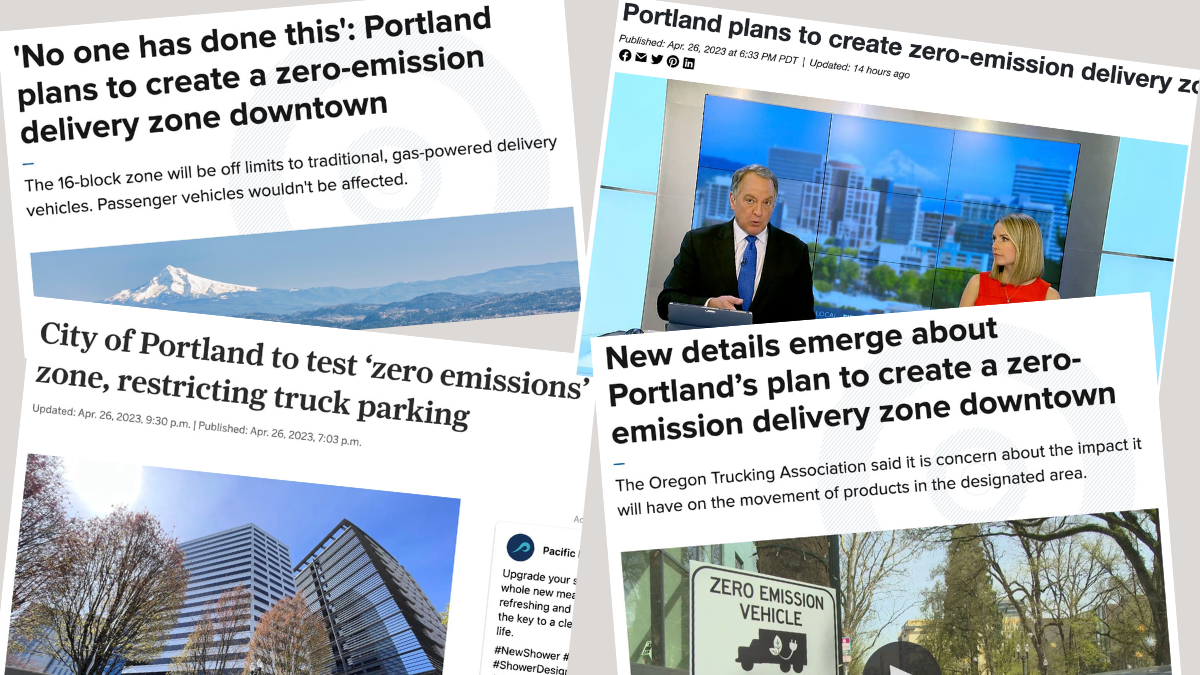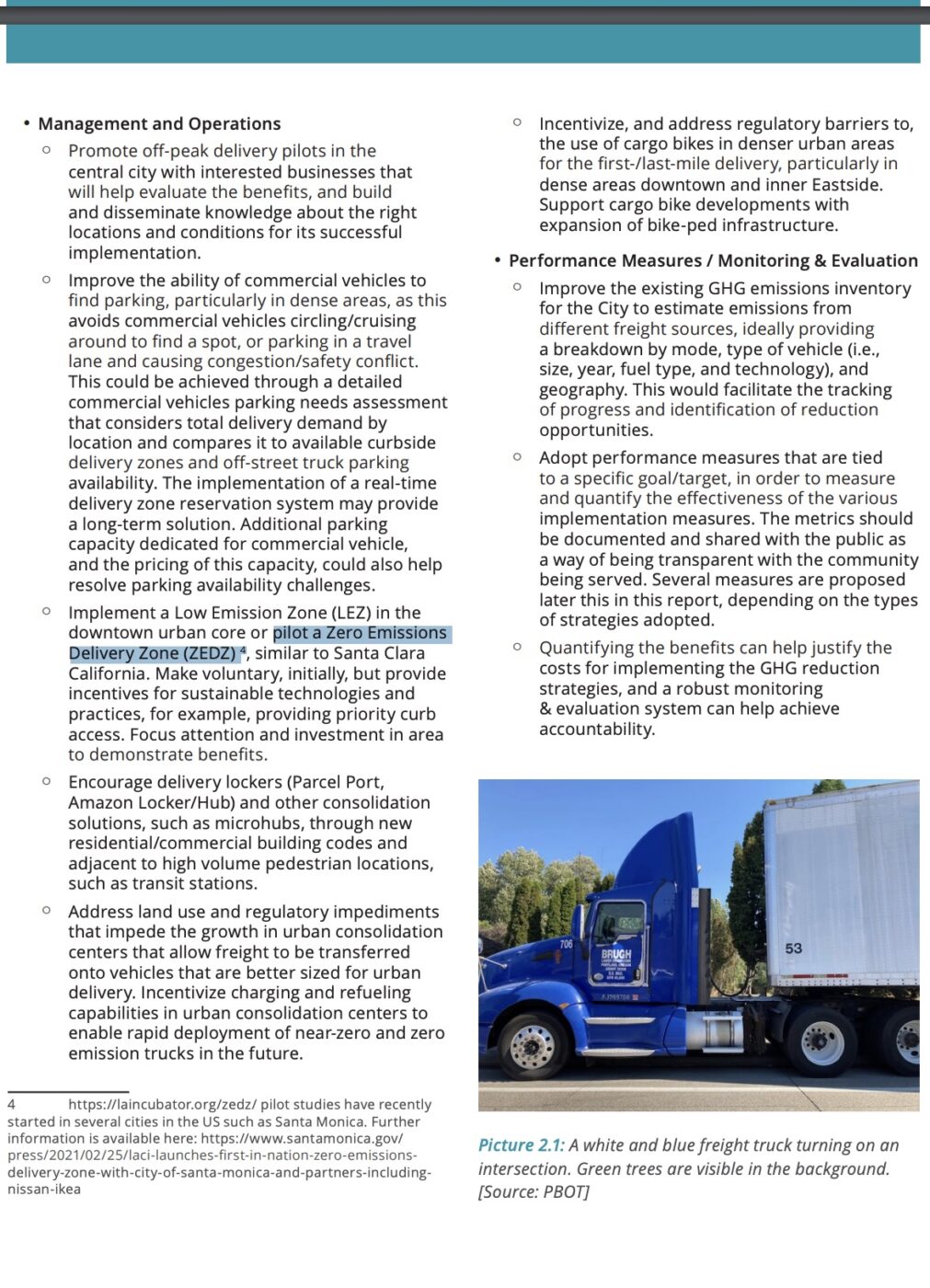
“We’re learning more about a controversial proposal that would reduce Portland’s carbon footprint while also adding an extra burden to struggling downtown Portland businesses.”
– KPTV news anchor
In their zeal to create controversy and feed their audience a narrative that makes the City of Portland look bad, many local media outlets have completely mischaracterized a new project launched by the Portland Bureau of Transportation on Wednesday. What is a relatively minor shift in how a few parking spaces will be regulated, is being framed as a sinister scheme by PBOT to ban trucks across a swath of downtown Portland and hurt local businesses at the same time.
As we were first to report on Friday, PBOT has won a $2 million federal grant to experiment with a “zero emission delivery zone.” Portland was selected as one of nine cities across America to partner with the US Department of Transportation on their new, Strengthening Mobility and Revolutionizing Transportation (SMART) grants program. We’re getting money from Uncle Sam to do something innovative that will improve air quality and make streets downtown safer. That’s it.
Before I critique the local media’s handling of this story, I’ll explain what we know so far about the project:
The details of the project are still being ironed out, but the basic gist is that PBOT will set aside a handful of loading zones outside three government buildings — the Portland Building, the Wendell Wyatt Federal Building, and the Multnomah County Courthouse — where only zero-emission delivery vehicles will be allowed to park. So far it looks like under a dozen loading zone parking spaces will be part of the pilot project, and all of them are in front of government buildings.
Also as part of the project, PBOT will work with B Line Urban Delivery (a company BikePortland readers are very familiar with) to encourage some freight companies to use B Line’s warehouse in the central eastside (on SE 7th) as a drop-off point where loads from larger, diesel and gas-powered trucks can transfer freight to smaller EVs (like B Line’s cargo trikes) before entering the central city. The other element of the project is that PBOT will use a bevy of new technology tools (“data from logistics companies, sensors, and third-party analytics companies”) to analyze and evaluate what happens at these zero-emission loading zones.
That’s pretty much it. But if you only caught a segment on a local network news TV station, you’d think PBOT was banning trucks downtown.
“We’re learning more about a controversial proposal that would reduce Portland’s carbon footprint while also adding an extra burden to struggling downtown Portland businesses,” said a very concerned-looking KPTV anchor. “One business owner is concerned this might cause financial impacts that could drive businesses out of the area.” KPTV (Portland’s Fox affiliate) interviewed two different business owners who panned the idea — neither of whom’s businesses will be remotely impacted by the project.
The Oregonian headline said, the City of Portland would be, “restricting truck parking.” Their story was fine and straightforward, but that headline isn’t really accurate because trucks aren’t restricted at all — just gas and dieseled-powered ones.
KGW got it totally wrong. Their headline blared, “No one has done this” and then their lede stated, “The 16-block zone will be off limits to traditional, gas-powered delivery vehicles.” Both of those statements are false. A city in Los Angeles piloted a zero emission delivery zone a few years ago. (It is a bit confusing that PBOT is saying this is a “first” in the nation; but I think they’re claiming that it’s the first “regulated zone,” or one that will actually be enforced with citations (the L.A. pilot didn’t have an enforcement element)).
KGW was so eager to gin up opposition to the idea they did a second story about it where they gave the president of the Oregon Trucking Association, Jana Jarvis, a platform to pan both PBOT and the project. Jarvis is the most influential trucking advocate in Portland and the state of Oregon. She chairs the PBOT Freight Advisory Committee (despite being termed out and serving long after new city rules allow) and is a member of the ODOT’s Mobility Advisory Committee (the rogue committee that has repeatedly overstepped its authority).
Here’s the exchange with Jarvis in the KGW story:
And some groups are already raising concerns about the impacts of the plan.
“We still don’t know what the zero-emission delivery zone parameters are or who will be affected by this unilateral decision, but we do know that zero-emission vehicles are not available for broad application in the trucking industry,” Jana Jarvis, President & CEO of the Oregon Trucking Association, said in a statement.
Jarvis, who is also chair of the Portland Freight Committee, said that the city applied for the grant last fall, but it was never mentioned in any committee meetings since then.
“The trucking industry is deeply disappointed by the lack of transparency from the City of Portland, and is very concerned about the impact this will have on the movement of products in the still undefined area,” Jarvis said.
First, Jarvis can’t claim to be blindsided by this project because it was included in the PBOT 2040 Freight Plan (on page 6 of this PDF) which was developed by the PBOT Freight Advisory Committee she chairs and discussed numerous times at meetings she attended.
And again, PBOT has simply announced a grant award and all they’ve shared is a basic outline of what the project might look like. So of course all of its impacts are unknown. To say however, that PBOT hasn’t been transparent and to share criticisms like this at this stage just seems very unfair.
KGW has a history of terrible transportation stories. Recall back in December when they followed the same formula in their outrageous hit piece on the new protected bike lanes on SW Broadway?
Another problem with how this project was covered by local media is that only one outlet (The Oregonian) even mentioned one of the biggest reasons it’s being done: safety. Drivers and their large trucks have claimed the lives of many Portlanders over the years. Reducing the size of trucks — especially downtown — has been the focus of numerous advocacy efforts over the years.
At yesterday’s press conference, Senior Advisor of Research & Technology at USDOT Ben Levine said, “Projects like these show that addressing safety priorities and addressing climate priorities are the same are two sides of the same coin…. This project asks and answers a critical question. How can our cities and communities best use public space to serve the needs of their residents in fostering safe places to move healthy places to live and vibrant places to be?”
And PBOT Commissioner Mingus Mapps (at his second positive news press conference for PBOT in as many weeks) got it right during in his speech in front of City Hall yesterday: “Electrifying our transportation system — from bikes, to personal vehicles and freight trucks — is critical… and will make our city healthier and will fight climate change. The closer freight operators get to zero emissions, the better it is for everybody. The safer streets will be, the less congestion we will have, and the less pollution we will breathe.”
So let’s get it straight: The sky isn’t falling, it’s just getting less toxic.
Note: I will say that the PBOT communications team didn’t do themselves any favors with how they rolled this project out. I feel like they might have rushed it to coincide with two transportation-related conferences that were in town yesterday an the fact that some USDOT staff were in attendance. Stay tuned for more coverage as this project gets fleshed out. There are some very interesting details I’m eager to learn and share more about.





